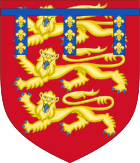House of Lancaster
| House of Lancaster | |
|---|---|
 As descendants of the sovereign in the male line the Earls of Lancaster bore the arms of the kingdom differentiated by a label azure of three points each charged with three fleurs de lys Or. The last male of this family was promoted to duke, which was then re-created for the second house. |
|
| Country | Kingdom of England |
| Parent house | House of Plantagenet |
| Titles |
Earl of Lancaster Earl of Leicester Count of Champagne and Brie Lord of Beaufort and Nogent Earl of Moray Earl Ferrers Earl of Derby Earl of Salisbury Earl of Lincoln Duke of Lancaster |
| Founded | 1267 |
| Founder | Edmund Crouchback, 1st Earl of Lancaster and Leicester |
| Final ruler | Henry of Grosmont, 1st Duke of Lancaster |
| Current head | Extinct in the male line |
| Dissolution | 1361 |
| House of Lancaster | |
|---|---|
 Arms of John of Gaunt, the arms of the kingdom differentiated by a label ermine. His royal descendants bore the arms undifferenced |
|
| Country | Kingdom of England, Kingdom of France |
| Parent house | House of Plantagenet |
| Titles |
Duke of Lancaster King of England King of France |
| Founded | 1362 |
| Founder | John of Gaunt, 1st Duke of Lancaster |
| Final ruler | Henry VI of England |
| Current head | Extinct in the male line |
| Dissolution | 1471 |
| Cadet branches |
|
The House of Lancaster was the name of two cadet branches of the royal House of Plantagenet. The first house was created when Henry III of England created the Earldom of Lancaster—from which the house was named—for his second son Edmund Crouchback in 1267. Edmund had already been created Earl of Leicester in 1265 and was granted the lands and privileges of Simon de Montfort, 6th Earl of Leicester, after de Montfort's death and attainder at the end of the Second Barons' War. When Edmund's son Thomas, 2nd Earl of Lancaster, inherited his father-in-law's estates and title of Earl of Lincoln he became at a stroke the most powerful nobleman in England, with lands throughout the kingdom and the ability to raise vast private armies to wield power at national and local levels. This brought him—and Henry, his younger brother—into conflict with their cousin Edward II of England, leading to Thomas's execution. Henry inherited Thomas's titles and he and his son, who was also called Henry, gave loyal service to Edward's son—Edward III of England.
The second house of Lancaster was descended from John of Gaunt, who married the heiress of the first house. Edward III married all his sons to wealthy English heiresses rather than following his predecessors' practice of finding continental political marriages for royal princes. Henry of Grosmont, 1st Duke of Lancaster, had no male heir so Edward married his son John to Henry's heiress daughter and John's third cousin Blanche of Lancaster. This gave John the vast wealth of the House of Lancaster. Their son Henry usurped the throne in 1399, creating one of the factions in the Wars of the Roses. There was an intermittent dynastic struggle between the descendants of Edward III. In these wars, the term Lancastrian became a reference to members of the family and their supporters. The family provided England with three kings: Henry IV, who ruled from 1399 to 1413, Henry V (1413–1422), and Henry VI (1422–1461 and 1470–1471).
...
Wikipedia
